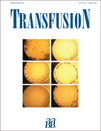Geno- and phenotyping and immunogenicity of HNA-3
Abstract
BACKGROUND: Alloantibodies directed against the human neutrophil alloantigen (HNA)-3a are frequently implicated in severe and fatal transfusion-related acute lung injury (TRALI). The HNA-3a/3b system results from a single-nucleotide exchange (461G>A; Arg154Gln) in the choline transporter-like protein 2 gene. Genotyping may allow identification of blood donors at risk to develop HNA-3a antibodies.
STUDY DESIGN AND METHODS: A polymerase chain reaction using sequence-specific primers (PCR-SSP) for genotyping of HNA-3a and -3b alleles was designed. Results of genotyping and phenotyping were compared in 40 randomly selected individuals and in blood donors and recipients of six TRALI cases associated with HNA-3a antibodies. Phenotyping was performed by granulocyte immunofluorescence and granulocyte agglutination using typing sera for HNA-3a and two recently found HNA-3b–reactive sera. Immunogenicity of HNA-3a was determined by the rate of HNA-3a alloantibodies in HNA-3b homozygous parous women.
RESULTS: Genotyping and phenotyping results correlated to 100% and were in accordance with alloantibody formation and binding in HNA-3a antibody associated TRALI cases. Gene frequencies of HNA-3a and -3b were 0.792 and 0.207 in the German population with 64.1% homozygous individuals for the HNA-3a allele, 5.5% for the HNA-3b allele, and 30.4% heterozygous individuals, in accordance with the Hardy-Weinberg equilibrium and the gene frequencies of 0.819 and 0.181 reported in 1964. Immunization rates were estimated to be of 7% for HNA-3a and 0.5% for HNA-3b.
CONCLUSION: The PCR-SSP method allows reliable determination of the HNA-3a and -3b genotypes; approximately 7% of HNA-3b homozygous women develop antibodies when exposed to the HNA-3a antigen during pregnancy.




